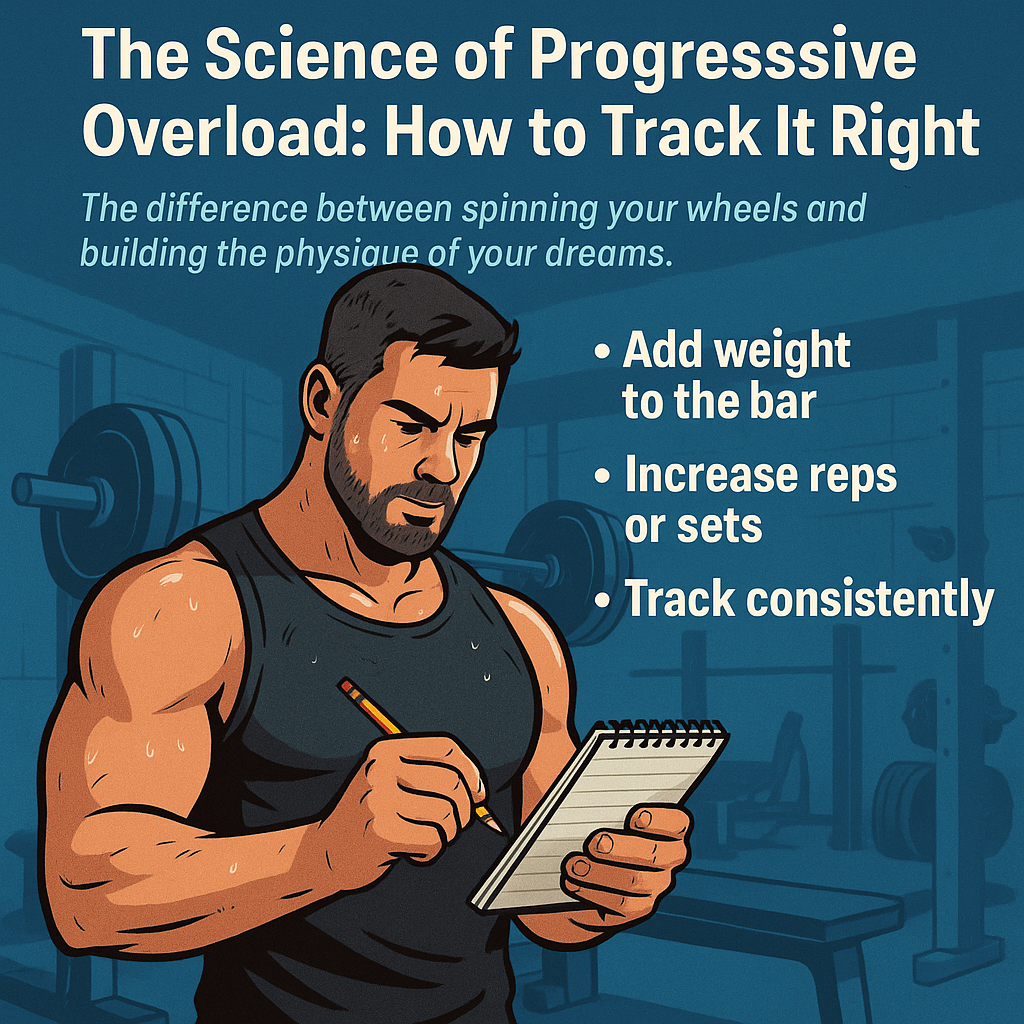The Science of Progressive Overload: How to Track It Right
The difference between spinning your wheels and building the physique of your dreams.
Here's a hard truth: 95% of people who start lifting never reach their potential.
Not because they lack dedication. Not because they don't train hard enough. But because they fundamentally misunderstand the single most important principle in all of strength training.
Progressive overload.
You've heard the term. You probably think you're doing it. But if you're not tracking it properly, you're leaving decades of gains on the table.
The Brutal Reality Check
Walk into any gym and you'll see them: the "lifetime intermediates."
- •Same weights for the past 2 years ✋
- •Same physique for the past 2 years ✋
- •Same strength for the past 2 years ✋
- •Still wondering why nothing changes ✋
They train hard. They eat right. They sleep well. So why do they look exactly the same as they did 24 months ago?
They're missing the secret sauce.
What Progressive Overload Actually Means
Progressive overload isn't just "add 5 pounds when you can." That's kindergarten-level understanding of a PhD-level concept.
True progressive overload is the systematic manipulation of training variables to force continuous adaptation.
The Hans Selye Discovery
In 1936, endocrinologist Hans Selye discovered the General Adaptation Syndrome:
1. Alarm Phase: Body encounters stress (your workout)
2. Resistance Phase: Body adapts to handle stress (muscle growth)
3. Exhaustion Phase: Body can no longer adapt (plateau)
The key insight? To keep progressing, you must keep progressing the stress.
The 7 Pillars of Progressive Overload
Most people only know about #1. Champions master all 7.
1. Load Progression
The obvious one everyone knows
- •Add weight to the bar
- •2.5-5lb increases for upper body
- •5-10lb increases for lower body
- •Mistake: Forcing weight increases when other variables could progress
2. Volume Progression
The secret weapon of bodybuilders
- •Increase total sets per week
- •Add reps to existing sets
- •Example: 3x8 → 3x10 → 4x8
- •Mistake: Only adding sets, never optimizing rep ranges
3. Density Progression
The conditioning component
- •Same work in less time
- •Shorter rest periods
- •More exercises per session
- •Mistake: Rushing recovery and compromising performance
4. Range of Motion Progression
The mobility multiplier
- •Deeper squats over time
- •Fuller bench press range
- •Complete deadlift lockouts
- •Mistake: Ego lifting with partial reps
5. Frequency Progression
The advanced strategy
- •Train muscle groups more often
- •Higher quality sessions
- •Better recovery management
- •Mistake: More = better mentality without recovery consideration
6. Technique Progression
The invisible gains
- •Better muscle activation
- •Improved movement efficiency
- •Enhanced mind-muscle connection
- •Mistake: Never focusing on quality improvements
7. Complexity Progression
The neural development
- •More challenging exercise variations
- •Unilateral to bilateral movements
- •Stability challenges
- •Mistake: Making exercises harder without purpose
Why 99% of People Fail at Progressive Overload
Problem #1: The Memory Myth
"I think I did 185 for 8 last week..."
Research from the Journal of Sports Sciences shows people overestimate their performance by 15-30% when relying on memory alone.
You're literally lying to yourself about your progress.
Problem #2: The Single Variable Trap
"I can't add weight, so I'm not progressing."
If you only track load, you're missing 6 other progression vectors. This myopic view kills long-term gains.
Problem #3: The Data Desert
"I write everything down... somewhere."
Inconsistent tracking = inconsistent progress. You can't manage what you don't measure.
Problem #4: The Analysis Paralysis
"I have the data, but what does it mean?"
Raw numbers without interpretation are just digital clutter.
The Progressive Overload Tracking System
Here's the exact system used by athletes who never plateau:
Phase 1: Data Capture (Weeks 1-2)
- •Record every exercise, set, rep, weight
- •Note RPE (Rate of Perceived Exertion) 1-10
- •Track rest periods between sets
- •Document technique cues that work
- •Goal: Establish consistent data quality
Phase 2: Baseline Analysis (Weeks 3-4)
- •Identify strength patterns across days
- •Find optimal rep ranges for each exercise
- •Establish recovery requirements between sessions
- •Goal: Understand your individual response patterns
Phase 3: Strategic Progression (Weeks 5-8)
- •Plan progressions before they happen
- •Choose primary and secondary progression methods
- •Set micro-cycle goals (weekly targets)
- •Goal: Systematic advancement across multiple variables
Phase 4: Optimization (Weeks 9-12)
- •Analyze what progressions yielded best results
- •Adjust training based on performance data
- •Plan deload and intensification phases
- •Goal: Personalized progression algorithm
The W8Log Advantage: AI-Powered Progress
Traditional tracking makes progressive overload harder than it needs to be. You're fighting against:
- •Cognitive load during training
- •Data entry errors from manual logging
- •Analysis complexity from massive datasets
- •Pattern blindness from information overload
What AI Changes:
Effortless Data Capture
*"Bench press today: 185 for 8, 8, 6. Felt strong, could have done more on first two sets."*
Your AI captures:
- •Exercise: Bench Press ✅
- •Sets: 3 ✅
- •Reps: 8, 8, 6 ✅
- •Weight: 185 lbs ✅
- •RPE: ~7 (estimated from "could have done more") ✅
- •Notes: Strong session, room for progression ✅
Intelligent Pattern Recognition
- •"Your bench stalls every 6 weeks—time for a deload"
- •"Squats respond best to volume increases, not weight"
- •"You're 15% stronger on Tuesday sessions vs Friday"
Automated Progression Planning
- •Suggests optimal weight increases based on RPE trends
- •Recommends volume adjustments when weight stalls
- •Predicts ideal deload timing before plateaus hit
Real-World Application: The 16-Week Transformation
Meet James: Lifetime intermediate, stuck at 185lb bench for 8 months.
Old Approach: Random weight increases, inconsistent tracking, no progression plan.
- •Result: 185lb bench → 185lb bench (0% gain)
New Approach: Systematic progressive overload with AI tracking.
Weeks 1-4: Baseline establishment
- •Consistent 185x8, 185x7, 185x6 performance
- •RPE averaging 8.5/10
- •Discovery: Responds better to volume than intensity
Weeks 5-8: Volume progression priority
- •185x8, 185x8, 185x8 (added 1 rep to final set)
- •185x9, 185x8, 185x8 (increased first set)
- •185x9, 185x9, 185x8 (volume progression continued)
- •185x10, 185x9, 185x9 (approaching next load jump)
Weeks 9-12: Load progression earned
- •190x8, 190x7, 190x6 (load increase unlocked by volume work)
- •190x8, 190x8, 190x7 (volume rebuilt at new weight)
- •190x9, 190x8, 190x8 (continued progression)
- •195x8, 195x7, 195x6 (second load jump)
Weeks 13-16: Advanced progressions
- •195x8, 195x8, 195x7 + 185x12 (back-off set added)
- •200x6, 195x8, 185x15 (pyramid approach)
- •200x8, 200x7, 200x6 (new plateau conquered)
- •Result: 185lb bench → 200lb bench (+15lb/8% gain)
The Compound Effect of Proper Tracking
When you nail progressive overload:
Month 1: 5-10% strength gains (neural adaptations)
Month 3: 15-25% strength gains (early muscle growth)
Month 6: 30-50% strength gains (significant hypertrophy)
Year 1: 50-100% strength gains (life-changing transformation)
Without tracking: Random, inconsistent, frustrating plateaus
With systematic tracking: Predictable, measurable, compound progress
Your Progressive Overload Action Plan
This Week:
1. Choose your tracking method (manual or AI-powered)
2. Record everything for 7 days straight
3. Don't worry about progression yet—focus on data quality
Next Week:
1. Analyze your patterns and identify strengths/weaknesses
2. Choose primary progression method for each exercise
3. Set specific targets for next 4 weeks
Following Month:
1. Execute your progression plan religiously
2. Adjust based on actual vs predicted performance
3. Plan your first strategic deload
The Bottom Line
Progressive overload isn't complicated—it's systematic.
The difference between those who transform their physiques and those who spin their wheels isn't talent, genetics, or even hard work.
It's the quality of their data and the consistency of their progression.
Your body is incredibly adaptive. Give it a reason to change, track that change, and plan the next one.
Stop guessing. Start progressing.
Ready to turn your training into a precision instrument? W8Log's AI makes progressive overload automatic, intelligent, and effortless.

